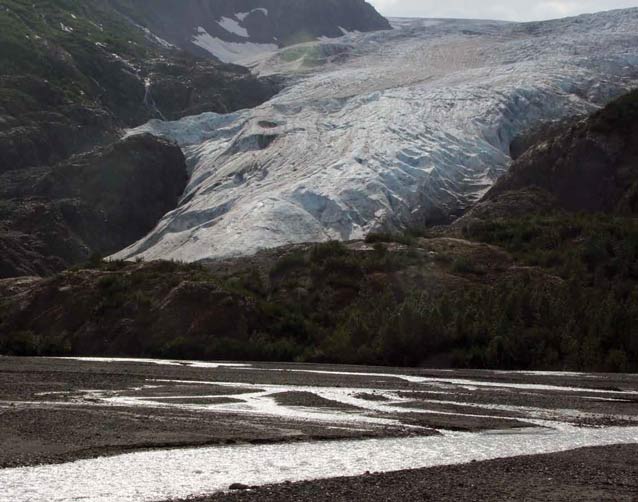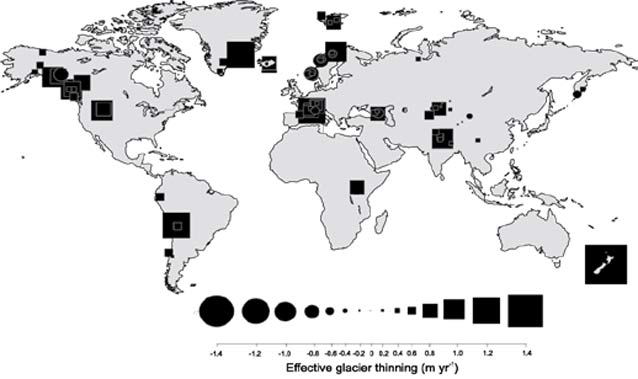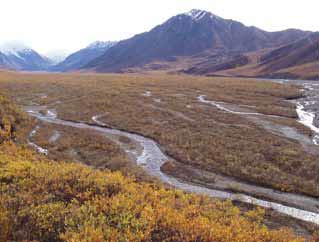Not only are most glaciers shrinking, the rate at which they are changing has accelerated over the last 2-3 decades. Over the last century, mid-latitude and arctic glaciers have generally been shrinking, while some in marginal environments have disappeared. This can have a significant impact on the species that live in glacier-fed rivers.

NPS Photo
Glaciers are distributed globally, covering about 10% of the Earth’s surface and storing about 75% of the world’s freshwater. Hence, glaciers contribute significantly to river flow and water resources across the globe (Fleming and Clarke 2005), and provide important ecosystem services for society in terms of hydro-power, agriculture, and water supply (Barnett et al. 2005). This is particularly the case in Alaska where approximately 35% of the runoff is from glaciers (Mayo 1986) and glacial runoff can have a marked effect on yearly, seasonal, and daily river discharge fluctuations where glacierization (glacier landcover) in a basin exceeds 5%. Much of this runoff originates from glaciers within Alaska national parks. Climatic conditions determine the total annual runoff from and the net storage of perennial snow and ice within the basin; hence inter-annual stream flow variations reflect glacier mass-balance fluctuations. Seasonally glacial rivers in the northern hemisphere typically have very low or no discharge in winter; flows begin increasing in early May as solar radiation increases to reach a summer peak at maximum glacier melt. Discharge then declines gradually until freeze-up in November and December. Glacierized environments are demonstrably one of the most vulnerable to climate change because of interconnections between atmospheric forcing, snowpacks/ glacier mass-balance, stream flow, water quality, and hydrogeomorphology (physico-chemical habitat), and river ecology (McGregor et al. 1995).
Not only are most glaciers shrinking (i.e. both thinning and retreating, see Figure 2), but that the rate at which they are changing has accelerated over the last 2-3 decades (Haeberli et al. 2007). Over the last century, mid-latitude and arctic glaciers have generally been shrinking (including most in Alaska), while some in marginal environments have disappeared (Meier et al. 2003). Measurements of glacier mass-balance outside polar regions are mainly negative, with a few exceptions e.g. Scandanavia.
Glaciers play a major role influencing river flow regimes with peak glacier-melt occurring during mid-late summer following retreat of the transient snowline (Hannah et al. 2005). The hydrological behavior of basins with as low as 10 % ice cover are strongly influenced by the balance between accumulation (gain) and ablation (loss) of glacier mass (Fountain and Tangborn 1985). Glaciers can maintain stream flow during the summer dry season when rivers in non-glacierized basins display low flow (Hannah et al. 2005). Rivers with meltwater inputs provide habitat for fisheries (Richardson and Milner 2004) and a number of rare and endemic macroinvertebrate species (Brown et al. 2007).

Hydrological Response to Retreating Glaciers
For larger receding glaciers, an initial increase in glacial meltwater generation may occur due to increased energy inputs, earlier disappearance of reflective snow cover and exposure of lower albedo ice (Milner et al. 2009).
This initial flow increase will be followed by reduced glacial runoff in the long-term due to an ensuing negative glacier mass-balance (Stahl et al. 2008). However for many smaller mountain glaciers reduced glacial meltwater runoff is occurring presently as glaciers recede.

NPS Photo
Glacier-fed Rivers and Their Biotic Communities
Many of the large glacier-fed rivers in Alaska (e.g. the Susitna River flowing from the south side of the Alaska Range in Denali National Park) possess a complexity of habitats adjacent to the main glacier-fed channel, including side-channels and side-sloughs. Juvenile king salmon use the side channels for rearing, whilst the turbidity and invertebrate drift into these channels can provide both cover and food resources. These side-channels and sloughs are sustained by melt waters of the main channel (Richardson and Milner 2004) and juvenile chinook salmon overwinter in these habitats. For many of these systems in northerly regions, winter is a critical period when overwintering mortality for salmonids can be high if they are unable to migrate to suitable refugia (i.e. channels off the mainstem). A significant positive correlation exists between the survival of young salmonids during the winter and the amount of winter discharge or winter groundwater inputs (Fleming 2005). Therefore, any changes in water source contributions that enhance winter flows would be beneficial to salmonid populations.
The effect of shrinking glaciers on fish populations will depend upon whether the reduction in mass-balance causes an initial increase in the glacial runoff contribution to the river system (as outlined earlier) or a decrease. Increased glacial runoff will cause an increase in summer flow peaks and potentially the duration of higher flows, which will enhance the migration of adult salmon to their spawning grounds, either in the river mainstem or in associated tributaries and off-channel habitats. Increased glacial runoff will also increase mainstem spawning habitat and cover in the side channels. This migratory and spawning habitat aspect of increased glacial runoff applies principally to larger systems fed by glaciers in Alaska and Canada.
Glacier-fed rivers support a unique flora and fauna driven by the overriding influence of water temperature and channel stability (Milner et al. 2001). However there is a strong temporal element to these conditions and in the spring and autumn when the glacial component is reduced, improved water clarity and channel stability in the channel allow for periods of extensive algal growth and benthic invertebrate production. These can be looked on as “windows of opportunity” for these organisms before and after the harsher conditions of summer when glacier melt is at its maximum.
Glacier-fed rivers close to the source are unique in that they support a deterministic assembly of macroinvertebrate communities that are similar worldwide due to the overriding variables of low channel stability and water temperature (Milner et al. 2001). A number of these taxa are cold stenotherms restricted to headwater reaches. With climate change and where glacial runoff becomes reduced, channel stability and water temperature will increase and suspended sediment/turbidity decrease. The development of stream macroinvertebrate communities in Wolf Point Creek in Glacier Bay with reduced percent glacierization of a remnant ice sheet provides some general insights into what will happen when glaciers retreat with reduced glacial runoff (Milner et al. 2008). There was a strong negative relation between % catchment glacierization in the Wolf Point Creek watershed and the diversity of the benthic community (Figure 4) with only five taxa (all chironomids) found in the stream at 70% glacierization which increased to 24 taxa at 0% glacierization. Of the chironomids (non-biting midges), Diamesa were not found when % glacierization was <15%. Baetidae (mayflie) were found at 60% glacierization, and Chloroperlidae (stoneflies), Limnephilidae (caddisflies) and Simuliidae (blackflies) <50% glacierization. Hydracarina and Cerapotogonidae occur for <10% glacierization and Coleoptera (beetles) and Gastropoda (snails) when glacial influence had disappeared. The principal mechanism of this change appears to be maximum water temperature, which has increased in Wolf Point Creek from 68 F (20 C) at 70% glacierization in 1977 to 64 F (18 C) at 0% glacierization in 2002 (r2 = 0.93 for water temperature vs. macroinvertebrate diversity). However, other mechanisms are involved in this change in community structure over time including biotic interactions and changes in geomorphological habitat (i.e. increase in glides and pools). Clearly, this evidence of a strong relationship between % catchment glacierization and macroinvertebrate taxon richness indicates that changes in glacial runoff into streams and rivers with glacier shrinkage will significantly change the structure of benthic communities.
These changes involve greater local (alpha) diversity and greater abundance which should benefit fish populations. However this is not the full story. Brown et al. (2007) suggested that some endemic species will be lost as glacial meltwaters decrease. This causes a decrease in overall regional (gamma) diversity as these cold stenothermic species become extinct from the regional pool and this was highlighted by Jacobsen et al. (2013) for other areas of the world than Glacier Bay, including the Andes and the European Alps.
Glacierized Valleys and Biological Hotspots in Alaska
In many large glacierized valleys of interior Alaska with gravel bed rivers, upwelling glacial runoff further down the floodplain supplies groundwater-fed channels. Some of these channels flow permanently throughout the year creating biological hotspots very different in character than the main channel. At these hotspots plant growth, particularly willow, is evident across the terrace of another wise barren floodplain. These groundwater fed-streams were characterized on a floodplain terrace of the Tolkat River in Denali National Park by Crossman et al. (2011) who showed they provide stable environments in terms of reduced variability in flow and water temperature regimes, with a negligible bed movement. These groundwater channels support higher diversity and abundance of macroinvertebrates than streams fed by surface runoff and can be important overwintering habitat for fish, like Arctic Char. A model using available satellite imagery and calibrated in Denali National Park and validated in Wrangell St. Elias National Park developed by Crossman et al. (2012) indicates these water-fed channels are extensively distributed throughout these two national parks. However time series analysis of aerial imagery of one of the floodplain terraces within the Tolkat River valley indicates the active length of these channels and the extent of vegetation along the length of the terrace has decreased over time, presumably due to reductions in the amount of glacier runoff as the glaciers shrink in mass balance. In terms of climate change, it is likely that the extent of these biological hotspots created by glacial runoff will decrease in the future with a reduction in the availability of these important habitats.
Glacial Recession and the Creation of New Habitat in Alaskan Parks.
An intriguing aspect of large scale glacial recession in coastal Alaska is the creation of new habitat open to colonization by biotic communities including anadromous salmon and other fish communities. Although many recently-formed streams are relatively short in length, potential recruitment of new salmon stocks is significant at a time when other stocks in the Pacific Northwest region of North America are threatened by anthropogenic activity. The recent creation of new stream habitat has been extensive along the coasts of southeast and southcentral Alaska (including both Glacier Bay and Kenai Fjords National Parks) linked both to climate change and local environmental conditions (Milner et al. 2008; 2011). In Glacier Bay, pink salmon (Onycorhnchus gorbuscha) have established substantial populations from a small colonizing population of spawners within a few generations, and other species rapidly colonize, including non-anadromous fish (e.g. sticklebacks) (Milner et al. 2008). Similarly in Kenai Fjords National Park in southcentral Alaska, 500 mi (800 km) northwest of Glacier Bay on the Kenai Pennisula, glacial recession has produced new stream habitat, notably in McCarty Fjord where McCarty Glacier has receded from a Neoglacial maxima in 1840. On the eastern side of the fjord this recession has created three streams all possessing lakes (dates of formation in brackets) as their principal source; namely Delusion (1980-1985), Desire (1935-1940), and Delight Lakes (1920-1925). Juvenile Dolly Varden were found to be the dominant salmonid in the younger system but were replaced by juvenile coho salmon in the older streams (Milner and York 2001). Due to the presence of lakes, sockeye salmon are also found and were first observed in Delusion Lake in 1987. By 1992, over 1000 sockeye salmon were spawning along the shallow margins of the upper lake. In less than 100 years sufficient numbers of sockeye salmon had colonized Desire and Delight Lakes to support a commercial fishery in McCarty Fjord that exceeded 50,000 in high years of the early and mid 1980s (Milner 1995). In recent years these numbers have declined, and the 10 year average to 2012 was 16,500 sockeye salmon. In addition almost 500,000 pink salmon were caught in the commercial fishery during the same time period associated with this district, many having their natal streams within Kenai Fjords. However in Glacier Bay, a number of sockeye salmon populations have been lost as lakes have been cut off or disconnected with stream development. Salmon carcasses left in the stream after spawning provide a significant source of marine-derived nutrients and organic matter, which can promote productivity in other parts of the ecosystem.
Summary
Glacier-fed rivers are unique biotopes with an inherent complexity that are widespread throughout Alaskan national parks. Climate change is predicted to have a higher impact at higher latitudes and altitudes, and these systems will be potentially susceptible to significant change that will affect their biotic communities including salmonid populations. Reduced glacial runoff will decrease the areal extent of upwelling channels and biological hotspots. The creation of new salmon habitat by glacial recession in coastal parks has added significantly to salmon stocks in Southeast and Southcentral Alaska.
Part of a series of articles titled Alaska Park Science - Volume 12 Issue 2: Climate Change in Alaska's National Parks.
Last updated: August 11, 2015
